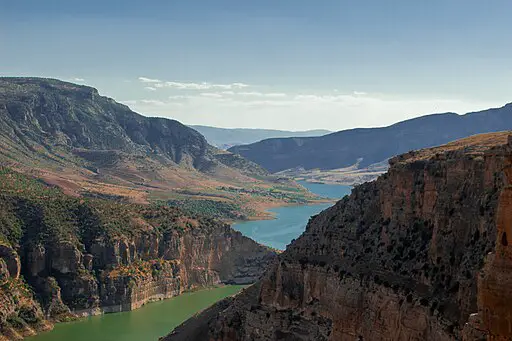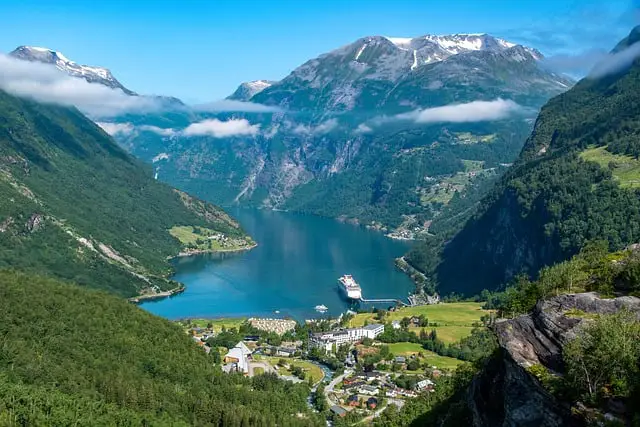Glacial valleys are U-shaped, formed by glaciers, while river valleys are V-shaped, created by rivers’ erosional processes over time.
TL;DR Glacial Valley Vs. River Valley
A glacial valley, as the name suggests, is formed by glaciers. Glaciers are massive bodies of ice that slowly move and erode the land. The movement of glacial ice carves out deep, U-shaped valleys with steep sides and a narrow width. These valleys typically have a flat floor and are often found in areas that have experienced past glaciation.
River valleys are formed by rivers and their erosive actions. Rivers gradually erode the land over time, creating V-shaped valleys with a wider and less steep profile compared to glacial valleys. River valleys often have a meandering shape and a fertile floodplain due to the deposition of sediment carried by the river.
What is a Glacial Valley?

A glacial valley is a type of valley that is formed by the movement of glaciers over thousands of years. Glaciers are large masses of ice and snow that flow downhill due to gravity. As glaciers move, they erode the underlying land, shaping the landscape and creating distinct features.
Key characteristics of a glacial valley include:
- U-Shaped Profile: Glacial valleys typically have a U-shaped profile, with steep sides and a flat or gently sloping bottom. This shape is a result of the erosive power of glaciers, which carve out the valley and remove the surrounding material.
- Distinctive Features: Glacial valleys often exhibit distinctive features such as hanging valleys, cirques, and moraines. Hanging valleys are smaller valleys that intersect with the main glacial valley but have different elevations. Cirques are bowl-shaped depressions at the head of a glacial valley, while moraines are the piles of debris left behind by retreating glaciers.
- Water Sources: Glacial valleys are typically fed by meltwater from glaciers. As the glaciers melt, the water flows down the valley, forming streams and rivers.
- Scoured and Smoothed Surfaces: Glacial erosion creates smooth, polished surfaces on the valley walls and floor. This is due to the grinding action of rocks and sediment carried by the moving ice.
- Examples: Examples of glacial valleys include Yosemite Valley in California, USA, and the Lauterbrunnen Valley in Switzerland.
In summary, a glacial valley is a distinct type of valley formed by the erosive action of glaciers. Its U-shaped profile, distinctive features, water sources, and scoured surfaces set it apart from other types of valleys.
How is a Glacial Valley Formed?
Glacial valleys are formed through various processes that involve the movement and erosion of glaciers. The first step in the formation of a glacial valley is the accumulation of snow in a mountainous region. Over time, this snow compacts and turns into ice, forming a glacier.
As the glacier moves, it acts like a bulldozer, scraping and eroding the land beneath it. The immense weight and pressure of the glacier cause it to pick up rocks and debris from the valley floor. This process, known as plucking, helps to deepen and widen the valley.
The movement of the glacier’s ice and the rock fragments within it creates further erosion through abrasion. The glacier grinds against the valley walls, wearing them down and smoothing the surface.
As the glacier continues to move, it shapes the valley into a U-shape, with steep, straight sides and a flat bottom. This distinct U-shape is one of the key characteristics of glacial valleys.
Glacial valleys are formed through the combined processes of plucking and abrasion by moving glaciers. The slow and steady movement of the glacier over thousands of years sculpted these unique and beautiful landscapes that we see today.
What are the Characteristics of Glacial Valleys?
- Glacial valleys are characterized by their unique features and formations. Here are the characteristics of glacial valleys:
- U-shaped: Glacial valleys have a distinct U-shaped profile, with steep sides and a flat bottom. This shape is formed by the erosive power of glaciers as they move and carve through the landscape.
- Striations and scratches: Glacial ice contains rocks and sediments, which act as abrasive tools. As glaciers move, they scrape and leave behind long parallel scratches on the valley walls and floor, known as striations.
- Hanging valleys: Glacial valleys often intersect with smaller side valleys called hanging valleys. These are formed when tributary glaciers merge with the main glacier, eroding the landscape at different rates.
- Moraines: Glacial valleys are often marked by the presence of moraines, which are piles of debris and sediments left behind by the retreating or melting glaciers. These moraines can be seen as ridges or mounds along the valley walls.
- Lakes and waterfalls: Glacial valleys commonly feature serene lakes, formed by the melting ice and accumulating water. Waterfalls may also be present, as the meltwater cascades down the steep valley walls.
- Fjords: In coastal areas, glacial valleys that were partially submerged by rising sea levels create fjords. Fjords are long, deep, and narrow valleys with steep sides that extend into the sea.
These characteristics make glacial valleys distinct and provide evidence of the powerful forces of ice that shaped them.
What is a River Valley?

A river valley is a type of landform that is formed by the erosive action of a river over thousands of years. It is characterized by the presence of a river channel, which cuts through the surrounding terrain, creating a V-shaped or U-shaped valley.
Key features of a river valley include:
- River Channel: The river itself is the primary feature of a river valley. It flows through the valley, eroding the surrounding land and shaping the valley over time.
- V-Shaped or U-Shaped Valley: River valleys typically have a characteristic V-shape or U-shape, depending on the erosive processes and the type of rock or sediment in the area. V-shaped valleys are narrower and have steeper sides, while U-shaped valleys are wider and have more gently sloping sides.
- Tributaries: River valleys often have smaller streams and tributaries that flow into the main river channel. These tributaries contribute to the overall erosion and shaping of the valley.
- Floodplains: Along the sides of the river, there may be flat areas known as floodplains. Floodplains are periodically flooded by the river, and this process helps to deposit sediment and create fertile soil.
- Meanders and Oxbow Lakes: In some cases, a river valley may exhibit meanders, which are bends or curves in the river’s course. Over time, meanders can lead to the formation of oxbow lakes, which are crescent-shaped bodies of water that were once part of the river channel.
River valleys are vital features of the Earth’s landscape, providing habitats for various plant and animal species. They also serve as important transportation routes, sources of water, and sites for human settlement and agricultural activities.
How is a River Valley Formed?
River valleys are formed through a process known as erosion. As water flows down a slope, it carries sediment and erodes the land, gradually forming a valley. The main factors that contribute to the formation of river valleys are the force of flowing water and the type of rock or soil in the area.
The force of flowing water plays a crucial role in shaping the land. As rivers flow, they cut through the land, gradually deepening and widening the valley. The speed and volume of water determine the rate of erosion, with faster-moving and larger rivers causing more significant changes to the landscape.
The type of rock or soil in the area also influences the formation of river valleys. Some rocks are more resistant to erosion, while others are easily eroded. Softer rocks or soils are eroded more quickly, leading to the formation of a wider valley. Harder rocks, such as granite, are more resistant to erosion and result in narrower valleys.
Over time, the continuous erosion and transportation of sediment by the river result in the formation of a V-shaped valley. The erosive power of the water creates steep sides, while the sediment deposits along the riverbed contribute to the flat valley floor.
Pro-tip: To explore the formation of a river valley, visit areas with different types of rock and observe how the rivers have shaped the landscape over time. Remember to always prioritize safety when exploring natural environments.
What are the Characteristics of River Valleys?
What are the Characteristics of River Valleys?
River valleys have distinct characteristics that set them apart from other types of valleys. These characteristics include:
- Shape: River valleys typically have a V-shaped profile. This shape is created by the erosive action of the river, which cuts through the land, forming steep sides.
- Depth: River valleys can vary in depth, depending on factors such as the volume and speed of the river. Some river valleys can be shallow, while others can be quite deep.
- Wide Bottom: River valleys often have a wider bottom compared to their sides. This is a result of the deposition of sediment carried by the river, which accumulates and creates a flatter, wider area.
- Water Source: River valleys are formed by the flow of water from various sources, such as rainfall, springs, and melting snow. The water collects and gathers momentum, eroding the land and forming the valley.
- Vegetation: River valleys are usually rich in vegetation due to the availability of water. The moisture provided by the river supports the growth of trees, plants, and other forms of vegetation.
- Biodiversity: River valleys are often home to a wide array of plant and animal species. The combination of water, fertile soil, and varied habitats creates an environment that supports diverse ecosystems.
These characteristics distinguish river valleys from other types of valleys, such as glacial valleys. Understanding these features can help in identifying and appreciating the unique qualities of river valleys.
What are the Differences Between Glacial Valleys and River Valleys?
When it comes to understanding the majesty of nature, it’s important to recognize the distinctions between glacial valleys and river valleys. In this section, we’ll explore the unique characteristics that set these two types of valleys apart. From their formation processes and distinct shapes to the sources of water that flow through them, we’ll dive into the geological features that make glacial valleys and river valleys truly remarkable. Get ready to embark on a journey through the captivating landscapes shaped by these forces of nature.
Formation Process
The formation process of glacial valleys and river valleys can be understood through the following steps:
- Glacial Valley Formation:
– The formation process of glacial valleys starts with the movement of glaciers over thousands of years.
– Glacial valleys are created in areas with heavy snowfall and cold temperatures due to the formation of glaciers.
– The accumulation of snow compresses and forms ice, initiating the formation process.
– Over time, the weight of the ice causes it to slowly flow downhill and erode the landscape, resulting in the formation of a valley.
– This erosion process shapes the valley into a U-shape with steep sides and a flat bottom. - River Valley Formation:
– River valleys undergo a formation process through the continuous flow of water over an extended period.
– The formation process of river valleys begins with precipitation, such as rain or snow, which collects in lakes or rivers.
– As the water flows downhill, it follows the path of least resistance and starts to erode the surrounding land.
– The erosive power of the water deepens and widens the valley as time progresses.
– The shape of the valley is determined by the type of rock and the strength of the river’s current, both of which influence the formation process.
Shape and Landscape
The shape and landscape of glacial valleys and river valleys exhibit notable differences. Here are some essential characteristics to consider:
- Glacial Valleys: Glacial valleys possess a U-shaped or trough-like contour. They boast broad and flat-bottomed structures, often accompanied by steep and towering sides. The topography typically appears rugged, characterized by sharp ridges, cliffs, and deep grooves forged by glaciers.
- River Valleys: In contrast, river valleys display a V-shaped or U-shaped appearance. These valleys are formed as a result of the gradual flow of rivers over time. Comparatively, river valleys tend to have broader, flatter floors and gentler slopes when compared to glacial valleys. The overall landscape of river valleys is generally smoother and less rugged.
The dissimilarities in shape and landscape arise from the distinct processes involved in their formation. Glacial valleys, for example, are shaped by the grinding and scouring action of glaciers, which erode and mold the land, resulting in the distinct U-shaped valleys that we observe today. On the other hand, river valleys are formed through the continuous flow of water, gradually eroding the surrounding land and giving rise to the V-shaped or U-shaped valleys.
Water Source
When comparing glacial valleys and river valleys, one of the key differences lies in their water source.
- Glacial valleys: The primary water source for glacial valleys is the melting glaciers themselves, as well as direct precipitation onto the valley. Glacial ice carves out these valleys, and as it melts, it creates streams and rivers within the valley.
- River valleys: In contrast, river valleys are formed by the erosive action of rivers over time. The water in these valleys mainly comes from the river itself, which is nourished by rainfall and other upstream water sources.
It is important to note that while glaciers serve as the water source for glacial valleys, rivers play that role in river valleys. The sources feeding rivers include rainfall, springs, and groundwater. The water in glacial valleys tends to be colder and more susceptible to sedimentation due to the presence of glacial meltwater. However, the water in river valleys is typically clearer and consistently provided by the river. Understanding the water source in each type of valley is vital for studying their ecological systems and the surrounding landscapes.
Geological Features
The geological features of glacial valleys and river valleys differ in several ways.
Geological features of glacial valleys:
- U-shaped: Glacial valleys exhibit a distinct U-shape, showcasing their unique geological features. This shape is characterized by steep sides and a flat bottom.
- Striations: Glacial valleys often showcase striations on the rock surfaces, depicting the impact of the moving glacier against the bedrock. These geological features provide evidence of the glacier’s presence.
- Erratics: Glacial valleys may contain large boulders known as erratics, which are clear indications of the glacier’s ability to transport and deposit massive rocks within the valley.
- Moraines: Glacial valleys are frequently marked by the presence of moraines, accumulations of rock, sediment, and debris left behind by the retreating glacier. These geological features offer insight into the glacier’s movement and retreat.
- Lakes: Glacial valleys commonly harbor lakes, as the depression left by the retreating glacier can become filled with water. These lakes are additional geological features that distinguish glacial valleys from other formations.
Geological features of river valleys:
- V-shaped: River valleys showcase a characteristic V-shape, which has been gradually formed by the erosive action of flowing water over time. Unlike glacial valleys, the sides of river valleys are less steep.
- Meanders: River valleys often display meanders, sinuous curves shaped by the river’s erosive power as it meanders across the floodplain. These meanders are prominent geological features of river valleys.
- Tributaries: River valleys are intricately interconnected with smaller tributaries, contributing to the flow of water and actively shaping the landscape. These tributaries are essential geological features that enhance the complexity of river valleys.
- Oxbow lakes: River valleys can also boast oxbow lakes, formed when a meander in the river is cut off, creating a curved body of water. These lakes add to the distinctive geological characteristics of river valleys.
- Alluvial deposits: River valleys are well-known for their alluvial deposits, which consist of sediment and soil carried and deposited by the river. These deposits result in fertile land and are yet another valuable geological feature of river valleys.
The geological features of glacial valleys and river valleys reflect the unique forces of glaciers and flowing water, respectively, shaping the land in distinct ways.
Frequently Asked Questions
What is the main difference between glacial valleys and river valleys?
Glacial valleys are shaped differently from river valleys primarily due to their formation process. Glacial valleys are created when solid ice cuts deep gouges into the earth, resulting in U-shaped valleys. In contrast, river valleys are formed by rivers slowly carrying away sediment along their banks, resulting in V-shaped valleys.
Why do glacial valleys have a U-shape?
Glacial valleys have a U-shape because of the wide and somewhat flat nature of glaciers. As glaciers move, they carve deep, wide gouges into the landscape, resulting in valleys with a distinct U-shaped cross-section.
How are glacial valleys formed?
Glacial valleys are formed through the erosive action of glaciers. As glaciers move, the solid ice plucks and scrapes away rock and sediment, creating deep gouges in the earth’s surface. This process, known as glacial erosion, shapes the formation of glacial valleys.
What are deposition forces in relation to glacial valleys?
Deposition forces refer to the process by which glaciers deposit sediment and debris they have picked up along their path. As glaciers melt and retreat, they leave behind large amounts of sediment, contributing to the formation and shaping of glacial valleys.
What is glacial plucking?
Glacial plucking is a process of glacial erosion where the solid ice of a glacier plucks or pulls away rock fragments from the underlying bedrock. As glaciers move and melt, they can detach and transport large boulders and rock pieces, further contributing to the shaping of glacial valleys.
How do river valleys differ in shape from glacial valleys?
River valleys differ from glacial valleys in shape primarily due to the erosional processes of rivers. While glaciers carve U-shaped valleys, rivers gradually erode their surroundings and carry away sediment, resulting in V-shaped valleys. River valleys also tend to have a narrower and more tapered appearance compared to the wider and flatter shape of glacial valleys.
Image Credits
Featured Image By – Zachtleven fotografie from Pixabay
Image 1 By – Empathictrust, CC BY 3.0 , via Wikimedia Commons
Image 2 By – Doğukan Birtekin, CC BY-SA 4.0 , via Wikimedia Commons








